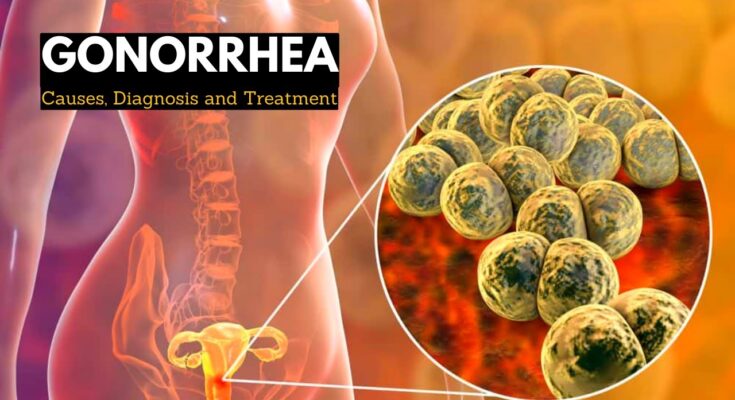Gonorrhea Treatment: Gonorrhea stands as one of the most prevalent sexually transmitted infections (STIs) worldwide, caused by the bacterium Neisseria gonorrhoeae.
Understanding the diagnosis and treatment of gonorrhea is essential not only for effective patient care but also for controlling the spread of this infection.
This article provides a comprehensive guide on the latest approaches and methods for diagnosing and treating gonorrhea.
Understanding Gonorrhea
Gonorrhea is a common sexually transmitted infection (STI) that affects millions of individuals worldwide each year. Understanding its prevalence, transmission methods, and symptoms is crucial for prevention and treatment. Here’s an overview designed to enhance clarity and accessibility for readers seeking information about gonorrhea.
Prevalence of Gonorrhea
Gonorrhea remains a significant public health challenge globally. According to the World Health Organization (WHO), it is one of the most common STIs, with an estimated 87 million new cases occurring each year worldwide. In the United States, the Centers for Disease Control and Prevention (CDC) reported over 600,000 cases in 2019, indicating a rising trend in incidence among various age groups, particularly among individuals aged 15 to 24.
How Gonorrhea is Transmitted
Gonorrhea is primarily transmitted through sexual contact, including vaginal, anal, and oral sex. The bacterium Neisseria gonorrhoeae, which causes the infection, can infect the mucous membranes of the genitals, rectum, throat, and eyes. It’s important to note that gonorrhea can be transmitted even if a man does not ejaculate during intercourse. Moreover, pregnant women with gonorrhea can pass the infection to their baby during childbirth, affecting the baby’s eyes and leading to serious health issues.
Symptoms of Gonorrhea in Different Genders
The symptoms of gonorrhea can vary significantly between genders and may also be mild or completely absent, making it difficult to diagnose without proper testing. Here’s what to look for:
Symptoms in Men:
- A burning sensation when urinating
- A white, yellow, or green discharge from the penis
- Painful or swollen testicles (although this is less common)
Symptoms in Women:
- Increased vaginal discharge
- Painful urination
- Vaginal bleeding between periods
- Pain during intercourse
- Abdominal or pelvic pain
It’s critical for individuals experiencing these symptoms to seek medical evaluation and testing to confirm the presence of gonorrhea, as untreated gonorrhea can lead to serious health complications, including infertility, pelvic inflammatory disease, and increased risk of acquiring or transmitting HIV.
However, practicing safe sex, using condoms, and having regular STI screenings are key strategies to reduce the risk of transmission and ensure early detection and treatment. If you suspect you may have been exposed to gonorrhea, contact a healthcare provider promptly for testing and appropriate treatment.
Diagnosing Gonorrhea
The Importance of Early Diagnosis
Early diagnosis of gonorrhea is crucial for effective treatment and prevention of complications. Gonorrhea, a common sexually transmitted infection (STI), can lead to serious health issues if left untreated, including pelvic inflammatory disease, infertility, and increased risk of contracting other STIs, including HIV. Early detection not only facilitates prompt treatment but also helps in curtailing the spread of the infection to others.
Types of Tests Used for Diagnosing Gonorrhea
Several diagnostic tests are available to confirm gonorrhea:
- Nucleic Acid Amplification Tests (NAATs): These are the most common and reliable tests for diagnosing gonorrhea. NAATs can detect the genetic material (DNA or RNA) of Neisseria gonorrhoeae, the bacterium that causes the infection.
- Culture Test: This involves growing the bacteria from a sample of body fluid from areas such as the cervix, urethra, rectum, or throat, which is then tested for gonorrhea.
- Gram Stain: A quick test performed primarily on males, where a sample from the urethra is stained and examined under a microscope. This test can show the presence of the bacteria but is less effective in diagnosing infections in women.
- Urine Test: Useful for detecting gonorrhea in the urinary tract and genital area, this test analyzes urine for the presence of bacteria’s genetic material.
How to Prepare for a Gonorrhea Test
Preparing for a gonorrhea test is straightforward and involves a few simple steps:
- Abstain from urinating: Avoid urinating for at least an hour before a urine test as it can help in obtaining a more accurate sample.
- Discuss medications: Inform your healthcare provider about any antibiotics or other medications you are taking, as these can affect test results.
- Provide honest information: Accurate details about your sexual history, symptoms, and any previous infections can guide the type of testing and treatment needed.
Common Misconceptions about Gonorrhea Diagnosis
Misconceptions about diagnosing gonorrhea can lead to anxiety and avoidance of testing. Here are a few common myths debunked:
Misconception: Gonorrhea always shows symptoms, so I don’t need a test if I feel fine.
Fact: Many people with gonorrhea do not experience symptoms, especially women. Testing is the only way to confirm if you are infected.
Misconception: Gonorrhea testing is painful.
Fact: Gonorrhea tests are usually quick and cause minimal discomfort. Most tests involve either a urine sample or a simple swab from the affected area.
Misconception: I only need to be tested if I have multiple sexual partners.
Fact: Anyone who is sexually active can contract gonorrhea, regardless of the number of partners. Regular screening is recommended for all sexually active individuals.
However, understanding these key aspects of diagnosing gonorrhea can aid in seeking timely medical advice and treatment, ensuring better health outcomes and preventing the spread of this treatable infection.
Gonorrhea Treatment Overview
Gonorrhea is a common sexually transmitted infection (STI) caused by the bacterium Neisseria gonorrhoeae. Effective treatment is crucial not only for alleviating symptoms but also for preventing complications and the spread of the infection to others. Here, we explore the general principles of gonorrhea treatment and the critical role that antibiotics play in managing this infection.
General Principles of Gonorrhea Treatment
The treatment of gonorrhea aims to eliminate the Neisseria gonorrhoeae bacterium from the body, alleviate symptoms, prevent complications, and reduce the transmission of the disease. The following points outline the general principles of gonorrhea treatment:
- Prompt Treatment: Early diagnosis and treatment are essential to prevent the spread of gonorrhea and its severe complications, such as pelvic inflammatory disease, infertility, and increased risk of HIV transmission.
- Use of Effective Antibiotics: Due to the rising rates of antibiotic resistance, selecting effective antibiotics is critical for the successful treatment of gonorrhea.
- Testing and Treatment of All Sexual Partners: Individuals diagnosed with gonorrhea are advised to inform all recent sexual partners so they can be tested and treated if necessary. This helps to prevent reinfection and control the spread of the infection.
- Follow-Up: Follow-up testing is recommended to ensure that the treatment has been effective, especially in cases where symptoms persist or reinfection is suspected.
- Prevention of Reinfection: Patients are counseled on practices that prevent reinfection and reduce the risk of contracting or spreading other sexually transmitted infections, including consistent condom use and mutual monogamy.
The Role of Antibiotics in Treating Gonorrhea
Antibiotics are the cornerstone of gonorrhea treatment. The choice of antibiotic has evolved over the years due to the bacterium’s developing resistance to many drugs previously used to treat it. Current guidelines recommend the following approach:
- Dual Therapy: The Centers for Disease Control and Prevention (CDC) currently recommends a dual therapy approach to treat uncomplicated gonorrhea. This typically includes a single dose of ceftriaxone, an injectable antibiotic, combined with azithromycin, an oral antibiotic. This combination helps cover potential co-infections like chlamydia and mitigates the risk of developing resistance.
- Resistance Monitoring: Healthcare providers monitor antibiotic resistance trends in their geographical areas to adjust treatment protocols accordingly. This ensures the continued effectiveness of prescribed treatments against gonorrhea.
- Research and Development: Ongoing research is crucial for developing new antibiotics and treatment strategies to outpace the evolving resistance of Neisseria gonorrhoeae.
However, the treatment of gonorrhea relies heavily on the effective use of antibiotics, prompt treatment, and comprehensive strategies to prevent reinfection and manage health risks. Public health efforts, combined with responsible antibiotic use and adherence to treatment guidelines, are essential for controlling this infection globally.
Treatment Options for Gonorrhea
Here, we explore the recommended treatment strategies, including antibiotics, alternative options for those with allergies, and special considerations for more complex cases.
Recommended Antibiotics for Gonorrhea Treatment
The cornerstone of gonorrhea treatment involves antibiotic therapy. According to health guidelines, ceftriaxone is the first-line antibiotic due to its high efficacy in eradicating the infection. It is crucial for healthcare providers to follow the latest guidelines to ensure the treatment remains effective against resistant strains of the bacteria.
Ceftriaxone and Its Dosage
For most cases of uncomplicated gonorrhea, a single intramuscular injection of ceftriaxone is effective. The typical dosage is 500 mg for individuals weighing less than 150 kg. For those weighing more, the dosage is increased to 1 gram to ensure adequate levels of the antibiotic in the body. This treatment is often combined with azithromycin or doxycycline to cover potential co-infections like chlamydia.
Alternative Treatments If Allergic to Standard Antibiotics
Patients who are allergic to ceftriaxone have other options. Alternatives such as azithromycin or doxycycline are considered, although their use may depend on local resistance patterns and the specific circumstances of the patient. It’s essential to discuss these alternatives with a healthcare provider to ensure the selection of an effective and safe treatment regimen.
Treatment Plans for Complicated Cases (e.g., Disseminated Gonorrhea)
In complicated cases, such as disseminated gonorrhea, which occurs when the infection spreads to other parts of the body, more intensive antibiotic therapy may be required. Treatment typically involves longer durations of ceftriaxone, potentially combined with hospitalization to closely monitor the patient’s response to the antibiotics. Such situations demand specialized medical oversight to manage the increased severity and potential systemic effects of the infection.
The Importance of Treatment Compliance and Monitoring
Adhering to the prescribed treatment regimen is crucial for the eradication of gonorrhea. Patients must complete the entire course of antibiotics even if symptoms improve, to avoid the risk of relapse or development of antibiotic resistance. Regular follow-up appointments are essential to confirm the infection has been effectively cleared and to monitor for any adverse reactions to the treatment.
However, treating gonorrhea effectively hinges on the timely administration of recommended antibiotics, consideration of alternative treatments when necessary, and strict adherence to treatment plans, especially in complicated cases. It is also vital for patients to engage in regular monitoring to ensure treatment success and prevent the further spread of the infection.
Managing Resistance to Gonorrhea Treatment
Here, we explore the complexities of antibiotic resistance in gonorrhea, discuss strategies to prevent the development of resistant strains, and look at ongoing research and future prospects in treating this infection.
Understanding Antibiotic Resistance in Gonorrhea
Antibiotic resistance occurs when bacteria change in response to the use of medicines, rendering those drugs less effective. Gonorrhea has progressively developed resistance to nearly every drug used for its treatment, starting from sulfonamides in the 1940s to the current first-line treatment, ceftriaxone. The emergence of strains resistant to this last-resort antibiotic is particularly alarming and underscores the need for a renewed focus on resistance management.
Strategies to Prevent Resistant Gonorrhea Strains
The best strategies to prevent the development of resistant gonorrhea strains involve both public health initiatives and individual actions. These include:
- Judicious Use of Antibiotics: Healthcare providers are encouraged to prescribe antibiotics only when necessary and to follow the recommended guidelines for gonorrhea treatment, which helps minimize the emergence of resistance.
- Enhanced Surveillance and Monitoring: Effective monitoring systems can track the prevalence of resistant strains, providing crucial data to adjust treatment protocols and prevent the spread of resistant bacteria.
- Public Education and Awareness: Educating the public about the importance of STI testing, safe sexual practices, and the risks associated with untreated infections can reduce the spread of gonorrhea and the development of resistant strains.
- Partner Notification and Treatment: Ensuring that all sexual partners are notified and treated if one partner tests positive for gonorrhea can help prevent re-infection and reduce the risk of spreading resistant strains.
Ongoing Research and Future Prospects in Gonorrhea Treatment
Research into new gonorrhea treatments is vital in the face of growing antibiotic resistance. Scientists are exploring several avenues:
- Development of New Antibiotics: Ongoing research aims to discover and develop new antibiotics that are effective against resistant strains of gonorrhea.
- Vaccine Development: There is an increasing interest in developing a vaccine for gonorrhea. A vaccine would be a significant breakthrough, providing a proactive method to prevent the infection and its spread.
- Alternative Therapies: Researchers are also looking into phage therapy and other non-traditional methods as potential treatments for antibiotic-resistant gonorrhea.
The future of managing gonorrhea effectively hinges on continuous research, public health strategies, and global cooperation. By staying informed and adopting responsible health practices, we can help combat the spread of this challenging infection and pave the way for more effective treatments.
However, managing resistance to gonorrhea treatment requires a multifaceted approach involving the judicious use of current therapies, ongoing research into new treatments, and robust public health strategies. By understanding and addressing the root causes of antibiotic resistance, we can improve the management of gonorrhea and ensure better health outcomes for affected populations.
Prevention and Education for Gonorrhea
Preventing gonorrhea, a common sexually transmitted infection (STI), involves a combination of practical measures and effective education. By understanding how to reduce the risk of transmission and where to access reliable resources, individuals can protect their health and well-being. Below, we outline key preventative strategies, the crucial role of education, and resources for further information and support.
Preventative Measures to Reduce the Risk of Contracting Gonorrhea
- Use Condoms Correctly: Consistent and correct use of condoms during vaginal, anal, and oral sex significantly reduces the risk of contracting gonorrhea. Latex condoms are the most effective, but if you’re allergic to latex, polyurethane or polyisoprene condoms are suitable alternatives.
- Regular Screening: Frequent STI screenings are crucial, especially if you’re sexually active with multiple partners or unsure of your partner’s STI status. Early detection can prevent complications and further transmission.
- Mutual Monogamy: Engaging in a long-term, mutually monogamous relationship with a partner who has tested negative for STIs can effectively prevent gonorrhea.
- Avoid Sharing Sex Toys: If sex toys are shared, they should be cleaned and covered with a new condom before use by another person to prevent the spread of gonorrhea.
- Communication with Partners: Open discussions with sexual partners about STI testing and general sexual health are essential. Transparency builds trust and enhances safety.
- Abstinence: The only surefire way to avoid gonorrhea is abstinence from sexual activities that expose you to risk.
The Role of Education in Preventing Gonorrhea
Education plays a pivotal role in preventing gonorrhea by empowering individuals with the knowledge needed to take proactive steps toward sexual health. Effective education helps debunk myths about gonorrhea and other STIs, promotes healthy sexual behaviors, and emphasizes the importance of routine STI screenings. Schools, community health programs, and online platforms can serve as powerful conduits for disseminating information about gonorrhea prevention and treatment.
Through these preventative measures and educational resources, individuals can significantly reduce their risk of contracting and spreading gonorrhea. Awareness and proactive health measures are key to managing the impact of this STI on public health.
Life After Treatment of Gonorrhea
Recovering from gonorrhea marks the beginning of an important phase in managing and maintaining your sexual health. After treatment, several steps are crucial to ensure full recovery, prevent recurrence, and protect your long-term health.
Follow-Up Testing and Practices After Treatment
Following successful treatment for gonorrhea, follow-up testing is essential. This is often referred to as a “test of cure” and is typically conducted one to two weeks post-treatment. This step ensures that the infection has been fully eradicated and helps in identifying any potential antibiotic resistance.
Practices to keep in mind after treatment include:
- Continued Safe Sex Practices: Use condoms or dental dams to reduce the risk of reinfection or contracting other sexually transmitted infections (STIs).
- Regular STI Screenings: Regular screenings are vital, especially if you have multiple partners or if your partner has not been tested and treated.
- Avoiding Sexual Activity Until Clearance: It’s advised to avoid sexual intercourse until a healthcare provider confirms that you are free of the infection.
Importance of Informing Partners About the Infection
Informing current and past sexual partners about your gonorrhea diagnosis is critical. This allows them to get tested and treated if necessary, which helps in preventing the spread of the infection.
- Communication is Key: Discuss openly and honestly with any partner with whom you’ve had sexual contact since your last test or in the months prior to your diagnosis.
- Encourage Treatment: Encourage partners to seek treatment even if they do not have symptoms, as gonorrhea can be asymptomatic but still harmful.
- Support and Privacy: Approach the topic sensitively to support your partners in taking the necessary steps without stigma or judgment.
Long-Term Health Considerations
If left untreated, gonorrhea can lead to serious health problems, including infertility in both men and women, and it can increase the risk of contracting other STIs, including HIV. Post-treatment, consider the following long-term health strategies:
- Monitor for Symptoms: Be aware of symptoms that may reoccur and seek medical advice if you notice anything unusual.
- Healthy Lifestyle Choices: Maintain a healthy lifestyle to support your immune system, which can help your body defend against infections.
- Annual Health Check-Ups: Regular check-ups with your healthcare provider can help monitor your overall health and prevent future complications.
Life after treatment of gonorrhea should focus on recovery, prevention of future infections, and maintaining overall sexual health. By following these guidelines, you can manage your health effectively and protect both yourself and others.
FAQs about Gonorrhea Treatment
1. What is the most effective treatment for gonorrhea?
The most effective treatment for gonorrhea typically involves antibiotics. The Centers for Disease Control and Prevention (CDC) recommends a dual therapy approach, which includes an injection of ceftriaxone and an oral dose of azithromycin. It’s crucial to follow your healthcare provider’s instructions precisely to ensure complete eradication of the infection.
2. Can gonorrhea be treated at home?
Gonorrhea should not be treated at home using over-the-counter products or home remedies. It requires specific antibiotics to be effectively cured. Attempting to treat gonorrhea without professional medical guidance can lead to complications and the spread of the infection.
3. How long does it take to cure gonorrhea?
Most symptoms of gonorrhea will begin to improve within a few days after starting treatment. It is important to complete the full course of prescribed antibiotics even if symptoms disappear, to ensure the bacteria is fully eradicated. Generally, it is advised to refrain from sexual activity for seven days after the completion of antibiotics to prevent transmission.
4. What should I do if symptoms persist after treatment?
If symptoms persist after you have completed the prescribed course of antibiotics, it is essential to return to your healthcare provider. You may require further testing and a different antibiotic regimen, as some gonorrhea strains have developed resistance to certain antibiotics.
5. Are there any side effects from gonorrhea medications?
Like all medications, those used to treat gonorrhea can have side effects. Common side effects include nausea, diarrhea, and allergic reactions. Discuss any concerns with your healthcare provider, who can provide advice on managing side effects and may adjust your treatment if necessary.
6. Can gonorrhea come back after treatment?
Re-infection with gonorrhea is possible if exposed again. Successfully treated gonorrhea does not provide immunity against future infections. To reduce the risk of re-infection, ensure all sexual partners are tested and treated if necessary, and consider consistent use of condoms.
Conclusion
Understanding the importance of timely diagnosis and treatment of gonorrhea is crucial for preventing serious health complications. This sexually transmitted infection, if left untreated, can lead to severe reproductive health issues and increase the risk of transmitting or acquiring other infections. Early intervention not only helps in managing the symptoms effectively but also in curtailing the spread of the disease.
If you suspect that you or someone close to you might be infected, it is vital to seek professional medical advice immediately. Consulting a healthcare provider ensures accurate diagnosis and appropriate treatment, which can significantly reduce the risk of long-term health problems. Remember, taking prompt action not only protects your health but also contributes to public health safety by preventing the spread of this infection.
Don’t hesitate to contact your doctor if you experience any symptoms related to gonorrhea, or if you have been potentially exposed to the infection. Early medical intervention is the key to a quick recovery and maintaining your overall health.
References
For those seeking additional information on gonorrhea treatment or wishing to verify the details discussed, the following reputable sources offer in-depth knowledge and the latest research findings:
- Centers for Disease Control and Prevention (CDC) – The CDC provides comprehensive guidelines on the diagnosis, treatment, and prevention of gonorrhea. This resource is invaluable for understanding the standard procedures and latest updates in treating this sexually transmitted infection. Read more about gonorrhea treatment on the CDC website.
- World Health Organization (WHO) – WHO offers extensive data and global guidelines on managing gonorrhea, focusing on treatment resistance and public health strategies. Their resources are crucial for anyone looking to understand the global impact and management strategies of gonorrhea. Explore WHO resources on gonorrhea.
- Mayo Clinic – As a leading healthcare organization, the Mayo Clinic provides detailed patient-oriented information on symptoms, causes, risks, and treatments for gonorrhea. Their website is a trusted source for patients and healthcare providers alike. Visit the Mayo Clinic’s page on gonorrhea.
- PubMed – For those interested in academic studies and peer-reviewed articles, PubMed is a vast library of medical publications. You can find numerous research articles on the effectiveness of different gonorrhea treatments. Search for gonorrhea treatment studies on PubMed.
- MedlinePlus – A service of the U.S. National Library of Medicine, MedlinePlus offers accessible health information on gonorrhea, including an overview of treatment options and links to further reading. Learn more about gonorrhea on MedlinePlus.
By consulting these sources, readers can ensure they are receiving the most accurate and up-to-date information available on the treatment of gonorrhea.



